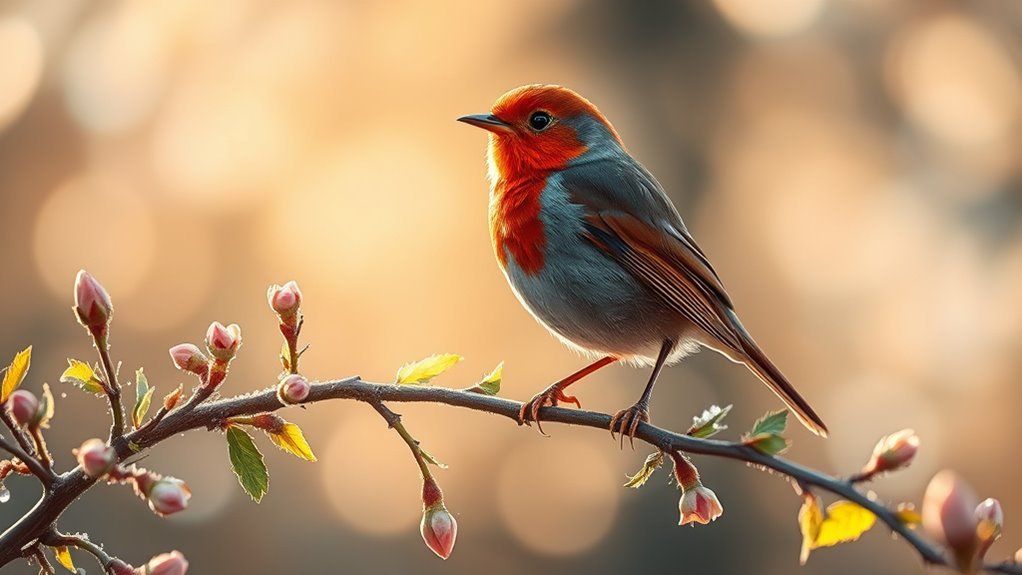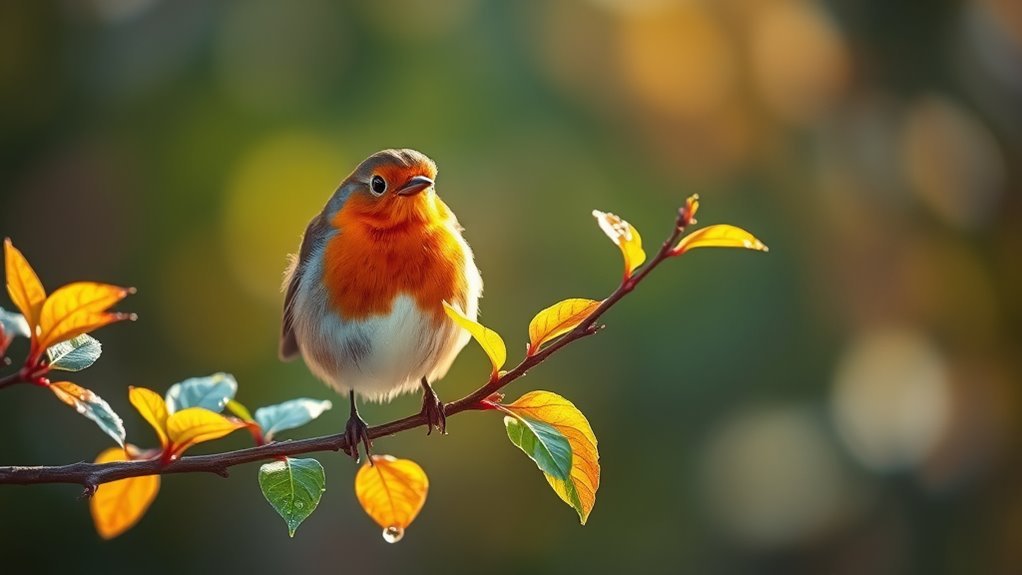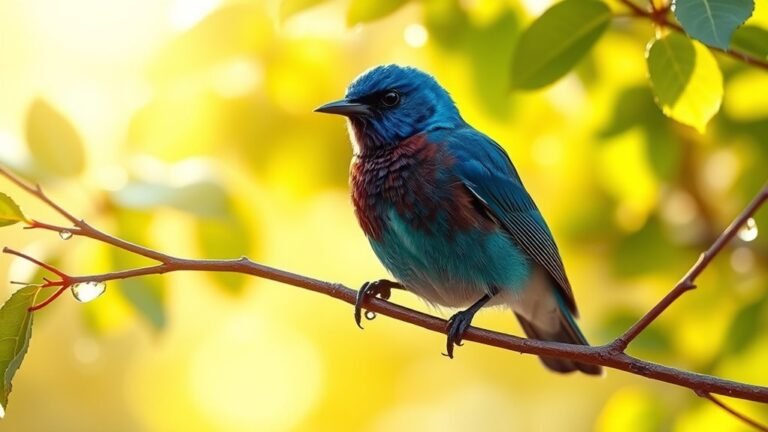Red Robin Bird Meaning Explained
The red robin has bright colors and sings sweet songs. These traits often represent renewal and hope. These birds adapt to their environment, making them interesting for study in ecology. Many cultures see them as signs or messages. Learning about red robins connects us to nature. What new facts can we find about this fascinating bird?
Key Takeaways
- Red robins symbolize renewal and rebirth, marking the arrival of spring and fostering connections to hope and growth.
- They act as messengers from the spirit world, embodying themes of new beginnings and comfort during difficult times.
- The bright red color of the robin represents energy and transformation, encouraging personal growth and connections to nature.
- In folklore, red robins reflect resilience and sacrifice, enriching narratives across various cultures and generations.
- Their uplifting presence serves as a reminder to embrace change and the natural cycles of life amidst challenges.
The Symbolism of Renewal and Rebirth

Red robins symbolize renewal and rebirth in many cultures. Their bright red feathers and cheerful songs often mark the arrival of spring.
This bird's migration each year highlights natural cycles and signifies the change of seasons. They build nests and care for their young, further supporting the idea of life continuing.
When you see a red robin, it can inspire feelings of hope and growth. This connection between nature and human emotions allows people to feel a sense of belonging in shared stories, emphasizing our desire for new beginnings and change.
The Red Robin as a Harbinger of Spring
Red robins are often seen as one of the first signs of spring. They leave their winter homes and catch the eye of both nature lovers and casual observers. Their arrival indicates important seasonal changes.
You can notice the ecosystem shift as they return, looking for warmer weather and fresh food. The presence of red robins often aligns with melting snow and plants beginning to bloom.
As the days grow longer, you may become more aware of these bright birds, watching them forage energetically and listening to their cheerful songs. Their return signifies a renewal of life.
Engaging with nature during this period fosters a sense of community, as you share the excitement of spring's arrival with others who enjoy the environment.
Cultural Significance Across Different Societies

Many cultures view the red robin as a vibrant bird. Its symbolism differs across societies.
In some Native American tribes, the red robin stands for renewal and resilience. It's linked to the beginning of new seasons.
In European folklore, the red robin symbolizes sacrifice and hope. Its red breast is often connected to Christ's resurrection.
Other cultures see the red robin as a symbol of protection and guidance, especially during difficult times.
These different meanings show how the red robin connects to human experiences. It serves as a symbol that brings people together across generations and communities, enhancing their shared stories and emotions.
The Spiritual Meaning Behind the Red Robin
Red robins carry significant spiritual meaning in many cultures.
These birds act as symbols of guidance, encouraging personal growth. Their bright red color signifies energy and renewal, indicating a fresh start in your life.
Here are three important aspects of the spiritual meaning of red robins:
- Change: Red robins symbolize transition, urging you to welcome new stages in your life.
- Nature Connection: They remind you of your deep link to nature and the universal spirit.
- Happiness: Red robins deliver messages of joy, encouraging you to find positivity, even during tough times.
Embrace the presence of red robins, and let their messages inspire you on your journey.
Good Fortune and Prosperity Associated With the Red Robin

A red robin often signifies good fortune and prosperity in your life.
Many cultures view birds, like the red robin, as symbols of luck. The bright red color of its chest is a clear sign of abundance and vitality.
Studies show that when red robins are present, it generally points to healthy environments, reinforcing ideas of prosperity. If you see a red robin, observe your current situation; it might indicate upcoming opportunities or financial growth.
Connecting with this symbolism can help you feel linked to nature's signs, reminding you that positive changes are coming.
The Red Robin in Folklore and Mythology
In many cultures, the red robin holds a significant place in folklore and mythology. This bird represents more than just good luck. Its appearance in stories reflects themes of rebirth, renewal, and transformation.
Here are three key points about the red robin in folklore:
- Rebirth: The red robin signals the start of spring. It symbolizes new beginnings and fresh starts.
- Messenger: Some traditions believe the red robin carries messages from the spirit world. It guides souls safely.
- Protection: The red robin acts as a guardian spirit. It offers comfort to those facing sorrow.
These stories highlight the deep connection between the red robin and human experiences. This bird enriches our understanding of belonging and hope.
Connection to Love and Relationships
The red robin is often linked to love and relationships in various cultures. This bird symbolizes romance and affection, especially during courtship rituals.
Its beautiful songs express emotions, similar to how people communicate their feelings. Many cultures believe that spotting a red robin signals the arrival of love, either renewing old relationships or starting new ones.
Recognizing the importance of the red robin can deepen your understanding of the connections we share, reminding you that love can be found in surprising places.
The Red Robin as a Guide in Dream Interpretation
When you dream of a red robin, it may signify important messages about your emotions and relationships. Here are three key meanings to consider:
- Joy and Renewal: The red robin represents new beginnings. This may signal a change in your life that brings happiness.
- Connection: Seeing this bird could highlight the need to connect with loved ones. It may be time to reach out and strengthen your bonds.
- Self-Expression: Dreaming of the red robin may encourage you to show your true self. This could lead to personal growth and fulfillment.
Reflect on these messages to guide you in your journey of self-discovery.
The Role of the Red Robin in Native American Culture
The red robin holds deep significance in Native American culture. Many tribes view the red robin as a messenger that connects the physical and spiritual worlds. Its bright red feathers represent life and renewal, mirroring the cycles found in nature.
Stories often depict the red robin guiding individuals through transitions, symbolizing hope and resilience. This bird is also linked to the arrival of spring, signaling important seasonal changes that align with farming and planting.
Understanding the symbolism of the red robin allows for a meaningful connection to Native American traditions, emphasizing a bond with nature and its wisdom.
Scientific Insights Into the Red Robin's Behavior
Red robins show interesting behaviors during their breeding season. Their nesting habits offer insights into their social structures and survival tactics. Here are three key points about their behavior:
- Nesting: Red robins build their nests in low, thick vegetation. This choice keeps their chicks safe from predators.
- Foraging: These birds search for food by looking for insects and fruits on the ground and in trees.
- Communication: Red robins use vocal sounds to communicate. This helps them establish social ranks and attract mates.
These behaviors highlight their adaptability and the important roles they've in their environments.
Conservation and Protection of the Red Robin
As human activities threaten natural habitats, effective strategies for conserving the red robin are essential. Preserving their habitats, such as woodlands, parks, and gardens, helps maintain their populations. You can support local efforts to protect these areas where red robins thrive.
Monitoring their populations is also crucial; tracking their numbers reveals trends in health and breeding. Participating in citizen science projects allows you to engage in these monitoring efforts and fosters community involvement in bird conservation.
How to Attract Red Robins to Your Garden
To attract red robins to your garden, follow these simple steps:
1. Plant Selection: Choose wildlife-friendly plants. Red robins like shrubs for nesting and perching.
These plants provide food and shelter.
2. Feeding Stations: Put up feeders with worms and berries.
Place them where there's nearby cover to keep the birds safe.
3. Water Sources: Install birdbaths.
Make sure they're shallow and close to shelter. This will encourage robins to drink and bathe.
By using these strategies, you can create a welcoming space for red robins in your garden.
Enjoy watching these beautiful birds!
Frequently Asked Questions
What Is the Lifespan of a Red Robin in the Wild?
In the wild, red robins usually live for about two years, but some can live up to five years. Their lifespan depends on the threats from predators, the availability of food, and the conditions of their environment. These factors play a significant role in their survival and ability to reproduce.
How Can Red Robins Be Distinguished From Other Similar Birds?
To identify red robins, look for their distinct feather patterns and bright colors. They have rust-colored chests and dark heads that differentiate them from similar birds. This appealing appearance attracts bird lovers and nature enthusiasts.
What Do Red Robins Eat in Their Natural Habitat?
Red robins find their food by looking for insects, berries, and fruits. They play an important role in their environment by helping control insect populations and spreading seeds. Observing their foraging habits can be interesting and can show how these birds contribute to nature. The red robin's diet is simple and essential for maintaining balance in its habitat.
Are Red Robins Migratory Birds?
Yes, red robins are migratory birds. They move seasonally to reach their breeding grounds. In the winter, they typically travel south. Learning about their migration can help you appreciate their role in the ecosystem during seasonal changes.
What Are the Common Predators of Red Robins?
Red robins face common predators like hawks and cats. These threats impact their nesting habits and territorial behavior. In response, red robins develop new strategies to protect their young. They stay alert and vigilant, ensuring their offspring remain safe from danger.

Hello, I’m Emily Price, the founder of Birds Affection. As a passionate bird enthusiast and spiritual seeker, I’ve always been fascinated by the symbolic meanings and mystical connections between birds and our lives. On this website, I share my knowledge and insights on the spiritual significance of various bird species, exploring their roles as messengers, guides, and teachers. Through my writing, I aim to inspire and educate others on the profound wisdom and beauty that birds bring to our world. Join me on this journey as we delve into the enchanting realm of bird symbolism and discover the hidden meanings behind these magnificent creatures.







